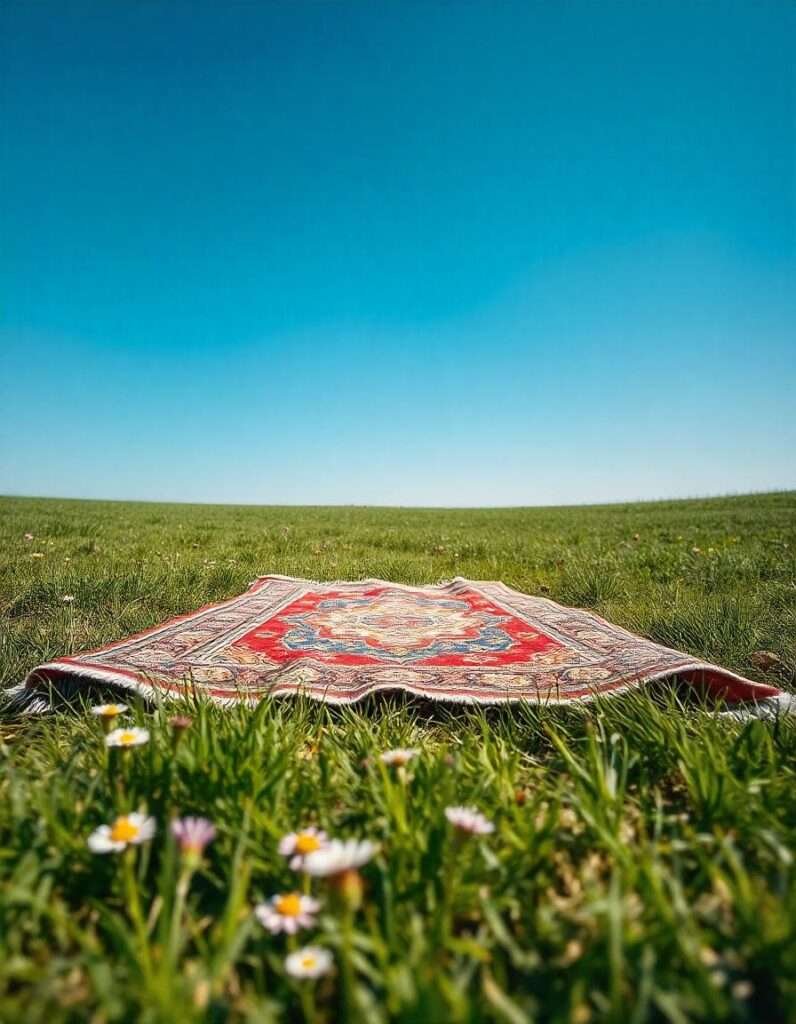
Imagine you’ve just finished cleaning your carpet, and now you’re staring at a damp area of fabric. You are wondering how on earth you’re going to get it dry before your house starts smelling like a wet dog.
Don’t worry I’ve been there too, and I’m here to walk you through everything you need to know about getting your carpet dry quickly and safely. Whether you’re dealing with a small area rug or wall-to-wall carpeting, these tried-and-true methods will help you achieve perfect results.
Understanding the Importance of Proper Carpet Drying
Let me tell you a quick story. Last summer, my neighbor decided to clean her carpets but didn’t dry them properly. Three days later, she called me in a panic about a mysterious musty smell that just wouldn’t go away.
That’s when I realized how many people underestimate the importance of proper carpet drying. It’s not just about avoiding wet socks but it’s about protecting your investment and your health.
Risks of Improperly Dried Carpets

Do you know that unmistakable musty odor that hits you when you walk into a room with a damp carpet? Well, that’s just the beginning of your problems if you don’t get your carpet properly dried. Here’s what you’re really risking:
- Mold and mildew growth, which can start in as little as 24-48 hours
- Bacterial growth beneath the carpet surface
- Carpet fiber damage and breakdown
- Delamination (when the backing separates from the carpet fibers)
- Bad odors that can last for months
- Potential health issues for your family and pets
- Staining from furniture legs or other items left on damp carpet
- Attraction of dust mites and other unwanted critters
Factors Affecting Drying Time
Before we dive into the how-to, let’s talk about what we’re up against. Imagine your carpet as a giant sponge. Its drying time depends on various factors that work together like a complex puzzle. Here’s what affects your carpet’s drying time:
1: Carpet Thickness and Material
Plush carpets hold more water than Berber. Wool carpets and double-padding underneath take longer to dry than synthetic. Age and wear affect absorption rates as well.
2: Environmental Conditions
Room temperature (ideal is 70-80°F), relative humidity levels, air circulation patterns, and weather conditions outside affect the drying time.
3: Cleaning Method Used
- Steam cleaning Vs dry cleaning
- Amount of water used
- Chemical solutions applied
- Pre-treatment processes
Essential Tools and Equipment
Let’s talk about what you’ll need in your carpet-drying process. Think of this like preparing for a camping trip, you want to be ready for anything.
Professional vs. DIY Drying Tools
You might be thinking, “Do I need all those tools that pros use? Well, here’s the truth though professional equipment is fantastic, you can achieve great results with the right home tools.
Must-Have Items for Carpet Drying
Listen, I’ve dried more carpets than I can count, and I’ll tell you straight up that having the right tools makes all the difference. Here’s what you’ll need, and trust me, these items are worth every penny.
Essential Equipment:
- A couple of good box fans (those cheap $15 ones just won’t cut it)
- A reliable dehumidifier (aim for one that can handle at least 50 pints)
- Stack of clean white towels (colored ones might bleed dye)
- Wet/dry vacuum
- Standing fan with oscillation
- Humidity meter
Nice-to-Have Items:
- Air mover (you can rent these from home improvement stores)
- Carpet-drying blocks or foam blocks
- Small portable fans for corners
- Extension cords (you’ll thank me later)
Step-by-Step Carpet Drying Methods

Let’s move to the step-by-step drying process:
1: Initial Water Extraction
Okay, here’s where most people mess up. They skip straight to the fans without doing proper water extraction. Big mistake! Here’s what you need to do:
- Start with your wet/dry vacuum. Work in straight lines, just like mowing a lawn. Seriously, don’t get creative here, straight lines are key.
- Go over each section at least three times. Yeah, I know it’s boring, but it’ll cut your drying time in half. I learned this the hard way after flooding my basement last spring.
- Press down firmly as you go. You’ll actually hear the water being sucked up. When that sound stops, move to the next section.
Pro tip: If you’re dealing with a really soaked carpet, empty your wet/dry vacuum when it’s half full, it works better that way.
Also Read: Hooked Rug Care 101: How to Clean Hooked Rugs like a Pro
2: Air Circulation Techniques
Below are some important air circulation tips for drying carpets.
Using Fans Effectively
Here’s a trick I learned from a professional carpet cleaner: think of your room as a mini wind tunnel. You want to create a continuous flow of air that doesn’t just blow on the carpet but moves across it.
Fan Positioning 101:
- Place your strongest fan at the main entry point
- Position secondary fans at corners, aimed at slight angles
- Run the ceiling fan on the wet carpet counterclockwise
- Keep all fans about 2-3 feet off the ground (stack them on chairs if needed)
Window and Door Positioning
Now, this part is tricky and depends on the weather. Here’s my rule of thumb:
Humid Day Strategy:
- Keep windows closed
- Run AC if you have it
- Create internal air circulation
- Use dehumidifier at full blast
Dry Day Strategy:
- Open windows on opposite sides of the room
- Create cross-ventilation
- Use fans to guide airflow
- Monitor humidity levels
3: Dehumidification Process
This is where things get scientific, but I’ll keep it simple. Your goal is to pull moisture from both the air and the carpet. Here’s how:
- Set the dehumidifier in the center of the room
- Empty it religiously – a full tank stops working
- Keep doors closed to the room
- Aim for 30-40% humidity (use that meter we talked about)
Pro tip: Place the dehumidifier on a slight elevation (like a sturdy chair) warm air rises, carrying moisture with it.
4: Advanced Drying Techniques
There are lots of advanced and updated tips for drying rugs:
Using Heating Systems
Temperature control is important, but don’t go crazy with the heat. Here’s what works best:
- Set thermostat to 75°F (23°C)
- Use space heaters strategically (keep them moving)
- Avoid direct heat on any one spot
- Monitor carpet temperature with your hand
Warning: I once cranked up the heat to 85°F thinking it would dry faster. Ended up with a slightly warped carpet backing. Don’t be like me!
5: Professional Grade Equipment
Look, I get it sometimes the basic setup just needs to be cutting it, especially if you’re dealing with a seriously soaked carpet. Let me tell you about the pro equipment you can rent and trust me, sometimes it’s worth the money.
Commercial Air Movers:
- These bad boys are like regular fans on steroids
- Cost about $30-40 per day to rent
- One unit covers about 200 square feet
- Position them at 45-degree angles for best results
Industrial Dehumidifiers:
- Way more powerful than home units
- Can pull 100+ pints per day
- Perfect for large spaces
- Might need special electrical outlets (heads up!)
Carpet Floating Systems:
- These create a tentlike effect on your carpet
- Force air underneath the carpet
- Great for serious water issues
- It is a bit tricky to set up, but it is super effective
Tips to Speed Up the Drying Process
Below are some extra tips that can speed up the drying process:
Room Temperature Control
Here’s something I discovered through trial and error. Temperature control is like conducting an orchestra. Every element needs to work together:
Morning Strategy:
- Open windows if it’s sunny and dry
- Let natural warmth in
- Run fans at medium speed
- Monitor humidity levels
Afternoon Approach:
- Close windows as temperature peaks
- Switch to AC if needed
- Adjust fan speeds to higher
- Keep air moving constantly
Evening Method:
- Reduce fan speeds slightly
- Maintain consistent temperature
- Keep dehumidifier running
- Check progress with your hands
Humidity Management
Let’s talk about managing moisture levels like a pro. I’ve got some tricks that really work:
Quick Tips:
- Use bathroom fans in nearby rooms
- Keep houseplants out of the area
- Avoid cooking or running hot showers nearby
- Check humidity every 2-3 hours
Signs You’re Winning the Battle:
- The carpet feels barely cool to touch
- No musty smells
- Humidity meter shows under 50%
- No squeaking sounds when walking
Advanced Speed-Drying Techniques

Here are some ninja-level tricks I’ve learned over the years:
Furniture Handling:
- Remove everything possible
- Use foam blocks under heavy pieces
- Keep at least 6 inches of clearance
- Rotate remaining items periodically
Carpet Lifting:
- Carefully pull up corners
- Insert small fans underneath
- Use clean paint stirrers to maintain gaps
- Check underneath periodically
Time-Saving Tricks:
- Roll up area rugs and dry them separately
- Use old towels for periodic blotting
- Create air channels with cardboard
- Switch fan positions every few hours
Post-Drying Care and Maintenance
As you have learned how to dry carpets after cleaning, now it’s time to learn its post-drying care and maintenance.
The 24-Hour Rule
Even when you think the carpet’s dry, give it an extra day. Here’s my post-drying checklist:
Day One:
- Keep light air circulation
- Run the dehumidifier on low
- Test various spots for dampness
- Look for any musty odors
Day Two:
- Vacuum thoroughly
- Reset furniture positions
- Check backing for firmness
- Look for any color changes
Long-Term Care Tips
Now that you’ve successfully dried your carpet, let’s keep it that way:
Preventive Measures:
- Consider carpet sealant
- Install humidity monitors
- Keep cleaning supplies ready
- Document what worked best
Troubleshooting Common Issues
Let me share some solutions to problems I’ve faced:
Stubborn Damp Spots:
- Double-check padding underneath
- Use targeted air circulation
- Consider lifting that section
- Apply moisture-absorbing powder
Odor Issues:
- Sprinkle baking soda overnight
- Use enzymatic cleaners
- Consider professional deodorizing
- Check for padding problems
FAQs
Help! My carpet’s been damp for three days! What now?
Don’t panic! First, check the padding underneath. If it’s still wet, you might need to lift the carpet and dry it from below. Consider calling a pro if you’re not comfortable doing this yourself.
Can I sleep in a room with a wet carpet?
While it won’t kill you, I wouldn’t recommend it. The high humidity can affect your breathing and sleep quality. Plus, why risk it? Give it at least one night in another room.
What if my carpet feels dry but still smells funny?
This usually means there’s still moisture trapped underneath. Try lifting corners and running fans underneath. If the smell persists after 48 hours, you might need professional deodorizing.
Is it okay to use a hair dryer to speed things up?
Please don’t! I tried this once and nearly ruined a patch of carpet. Stick to proper air movement and dehumidification.
How can I tell if mold has started growing?
Watch for musty odors, discoloration, or allergic reactions. If you suspect mold, don’t wait, call a professional immediately. Some things aren’t worth risking!
Conclusion
Drying your carpet isn’t just about getting rid of moisture rather it’s about doing it right to protect your investment. I’ve learned these lessons through years of experience and yes, some mistakes along the way.
Remember, patience really is key here. It’s better to take an extra day drying than to rush and deal with mold or odors later. Remember, every carpet and situation is different, but these guidelines have served me well over the years.
